Steamed Colocasia Leaves Pinwheels (Pathrode or pathrado or pathrodo)
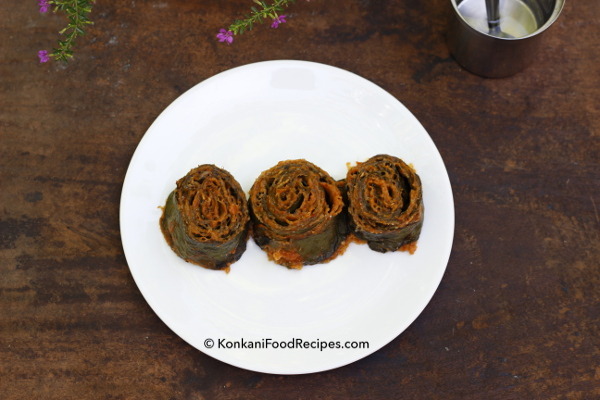
Konkani’s love for pathrado is undescribable. Pathrado is the King of Konkani cuisine. Konkanis go crazy the moment they see colocasia leaves. We have to make some delectable pathrado out of colocasia leaves and enjoy them steaming hot with loads of oil on top. :-) Well, that's true. I'm not exaggerating.
Pathrado is a Konkani cuisine delicacy. They are pinwheels prepared using colocasia leaves. Also called as pathrode in Kannada, alva panna pathrado in Konkani. A spicy batter is prepared by grinding rice, grated coconut, tamarind, and red chillies. This batter is smeared on colocasia leaves, which are then rolled, sliced and steamed. These steamed pathrode slices are then had with lots of coconut oil on top and are enjoyed while they are hot or cold. Steaming hot pathrode right out of the steamer with lots of coconut oil on top is absolute heaven!
Pathrode are made by steaming, shallow frying and even by deep frying colocasia leaves pinwheels. Here's a basic video on how to make pathrado.
Watch all about Pathrado making here:
And with the love for pathrado that we Konkanis have, we definitely don’t waste any leftovers. Leftover pathrode are turned into lip smacking dishes again. :-) We shallow fry pathrode slices with oil to make them crispy and enjoy them hot. We also add leftover pathrode into a spicy coconut curry and enjoy it with rice. This curry is called pathrode gashi in Konkani. We use leftover pathrode to make a tasty, spicy, sweet pathrode stir fry called as pathrode usli.
Pathrado is a must dish for festivals like Ganesh chaturthi, suthapunav (a festival celebrated on a full moon day once a year). In most Konkani homes pathrado is prepared atleast once a week.
Pathrode is prepared using different types/varieties of colocasia leaves. Here are certain tips you need to follow while you forage for colocasia leaves to make pathrode:
- Use tender most colocasia leaves for super soft pathrode.
- Use tender colocasia leaves as much as possible as they tend to have less calcium oxalate in them. Calcium oxalate crystals in colocasia leaves is responsible for the itching/stinging sensation in your throat, mouth after eating colocasia leaves. Do not use very mature, aged colocasia leaves. They could give rise to a lot of itching even after cooking.
- While you pick colocasia leaves pick the ones that have just opened up & grown and the leaf just below it. Called as suli paan & the one just below it. Do not use mature colocasia leaves, as they tend to have high calcium oxalate in them that causes itching.
Colocasia leaves are called 'alva paan, pathrade paan' in Konkani. Thus, pathrado are also called as alva panna pathrado.
If spreading masala on leaves are the most difficult part for you, the above video should help:
Ingredients:
- 25-30 colocasia leaves
- 1 cup dosa rice/medium grained rice
- 3/4 - 1 cup grated coconut (more coconut you add, softer pathrado you make)
- 1 lemon sized tamarind/3-4 bilimbi
- 10-12 red chillies
- Salt to taste
- Jaggery to taste
- A pinch of asafoetida
Serves: 3-4
Preparation Time: 50-60 minutes
Preparation Method:
Preparing the masala:
1. Soak dosa/medium grained rice for atleast half an hour. After it's been soaked, wash and drain all the water.
2. Grind rice with tamarind, red chillies, salt, jaggery, grated coconut, asafoetida (soaked for few minutes to soften), using as little water as possible into a dry, coarse paste.
3. Transfer the batter into a bowl and keep it aside. This ground rice batter is called 'pathrade peet' in Konkani, peet meaning batter in Konkani.
Preparing pathrado:
4. Chop off the stem portion from the colocasia leaves. Carefully remove any thick veins present in the center, on the back of the colocasia leaves using a sharp knife. Take care not to tear off colocasia leaves while you devein them.
Tender colocasia leaves have very little developed veins and do not require deveining. When you use mature colocasia leaves make sure you devein the leaves completely to avoid itching/stinging sensation on cooking.
Tender colocasia leaves: (tarne alva paan in Konkani, tarne meaning tender)
Mature leaves tend to have fully grown veins on the backside of the leaves. (June alva paan in Konkani, june meaning mature in Konkani)
Leaves after deveining them:
The process of deveining colocasia leaves is called as 'narb kadache' in Konkani, narb meaning veins and kadche means removing in Konkani.
5. Wash colocasia leaves well and keep them aside so that all the excess water drains out.
6. Once all the excess water drains out, start making a pinwheel - Alva panna lolo in Konkani. Watch how to make pinwheels - lolo
7. Keep the biggest leaf upside down on a clean surface. The pointed end of the leaf should be facing away from you. Apply a layer of ground masala uniformly on the back of the leaf. Using your fingers cover the entire leaf with a layer of masala.
This process of smearing a layer of ground rice batter over colocasia leaves is called as 'pathrado saroche' in Konkani, saroche meaning smearing in Konkani.
8. Keep another leaf on the first leaf and repeat till you have a stack of 8-10 leaves (depending on how thick/thin you want your pathrado rolls and slices to be) with a coating of masala on them.
While making a pinwheel/pathrado, make sure you add enough batter all over the colocasia leaves. Lots of tamarind used in the rice batter helps breakdown calcium oxalate crystals present in colocasia leaves.
9. Size of colocasia leaves vary, try to distribute the leaves you place, uniformly on the biggest, lower leaf so that you get a uniform thickness pathrode roll later on.
10. Fold the stack of leaves on either sides as shown below and apply masala on them.
11. Start rolling it from one end. Start from your end and work towards top. Continue rolling till you reach the other end.
12. Roll them tightly or else while you cut them into slices, the layers/leaves tend to open up.
These rolls are called as 'pathrade lola' in Konkani.
13. Repeat the above smearing, rolling process with rest of the colocasia leaves.
14. Meanwhile get a steamer going.
15. Chop each roll into thin slices of 1 - 2 inch thickness using a sharp knife. While cutting them into slices, hold the roll firmly with your hand and be careful not to press them hard with your fingers, to prevent the masala from oozing out.
These slices are called 'pathrade phodi' in Konkani.
16. Then place the slices inside the steamer. You can stack the slices one upon another in the steamer.
17. Steam them for 15 minutes on high flame and then for 30 minutes on medium to low flame.
18. Serve pathrode steaming hot with lots of coconut oil on top. Steaming hot pathrode will be super soft.
If you are looking to serve good looking, firm pinwheels, then leave the steamer little open for 10-15 minutes after steaming and then take out the pinwheels/pathrado.
Serving suggestions:
Serve steaming hot pathrode with loads of coconut oil on top as a side dish for lunch.
In our house we enjoy steaming hot pathrode with lots of coconut oil as soon as they are steamed. They are super soft then. With time as they cool down, they tend to lose their softness.
At home we steam pathrode just in time for lunch/dinner, so that we can enjoy them soft, steaming hot with rice and dalithoy or with any other curry. :-)
Using leftover pathrado:
Any left over pathrados can be used in 3 ways:
1. Fry them on a frying pan with lots of oil until they get crisp. Serve them hot as a side dish for lunch, dinner.
Leftover pathrode tends to get a little hard on cooling. They lose their softness. On regfrigerating these leftover pathrode they get even more hard and lose their taste. Shallow frying them with oil with make them soft and fresh. Shallow frying them with lots of oil for a longer time will make these pathrode crispy. I just love those crisp pathrados with a heavenly taste of coconut oil.
2. You can make pathrade gashi with leftover pathrode. A delicious coconut curry with pieces of pathrode in it.
3. Or you can make a delicious, sweet, spicy stir fry out of leftover pathrado called as pathrade upakari/usli in Konkani.
Side Note:
- Use enough tamarind/bilimbi in the rice batter to prevent itching/stinging sensation pathrode could cause after they are steamed.
- Eating partially cooked pathrode may cause itching in the throat & mouth, which may last for a few hours. So, steam the pathrados well.
- In case you experience itching/stinging sensation in your mouth, throat, drink sour buttermilk (or curds) for the itching to go away.
- While you handle colocasia leaves, be it chopping, deveining, washing them for that matter, they could irritate your skin and cause itching. To avoid itching apply tamarind water, lemon juice to your hand before contact or after contact with colocasia plants/leaves. Apply tamarind water, lemon juice and then wash your hand with hot water to reduce itching.
- Soaked green gram is added to the rice batter while grinding to counteract the heat the spicy pathrode could bring into your body. If you wish to use green gram soak them for about 3-4 hours and then add it to the batter while grinding.
- Use red chillies depending on how spicy you like your pathrode to be.
- Steamed pathrados turn out super soft and taste best when you use a specific varieties of colocasia leaves to make them. These varieties are called as tere paan, pandvala paan in Konkani. They have soft leaves that turn super soft on cooking and they make the best, super soft pathrados. For pictures of these varieties click here.
- Steamed pathrados can also be made using other varieties of colocasia called as marvala paan, bombay alva, chitte paan in Konkani. Leaves of these varieties of colocasia are a little thick and need proper, longer cooking and enough amounts of tamarind/bilimbi to cut out their itching. For pictures of these varieties click here.
Find more Konkani cuisine side dishes here.
Tags: side dish, colocasia leaves, Konkani recipe, Konkani dish, Konkani cuisine, Udupi cuisine, Mangalore food, Konkani food, pathrado, pathrode, patrado, alva paan
Chauthi



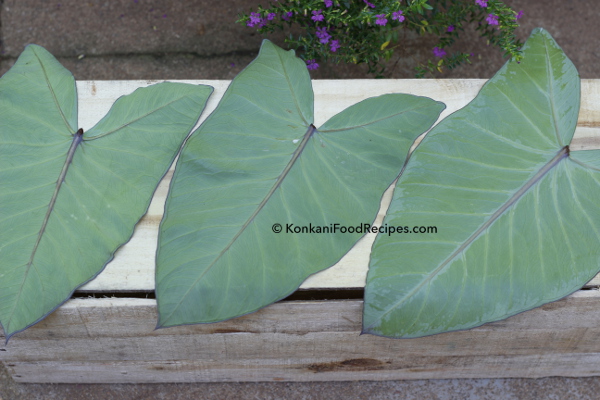




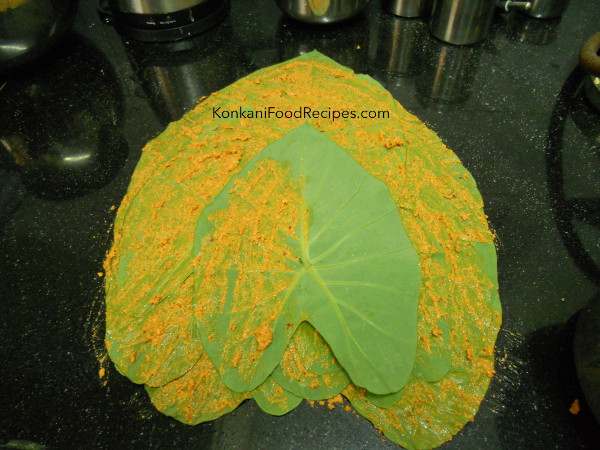

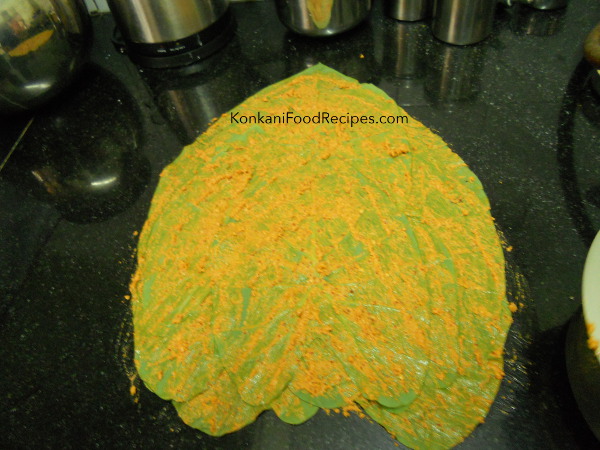
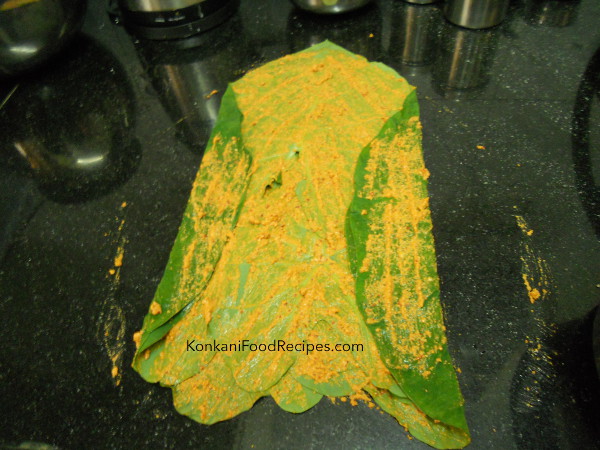

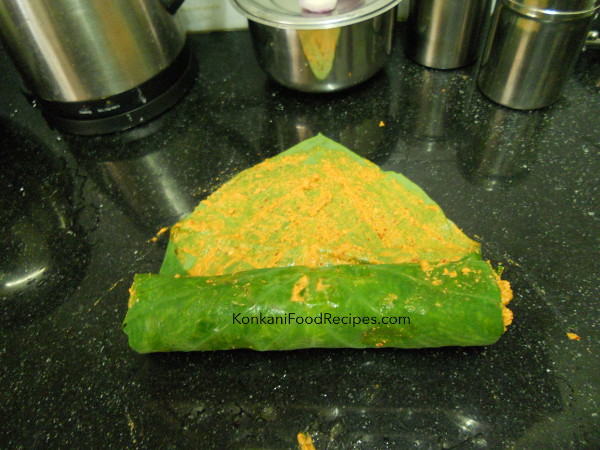
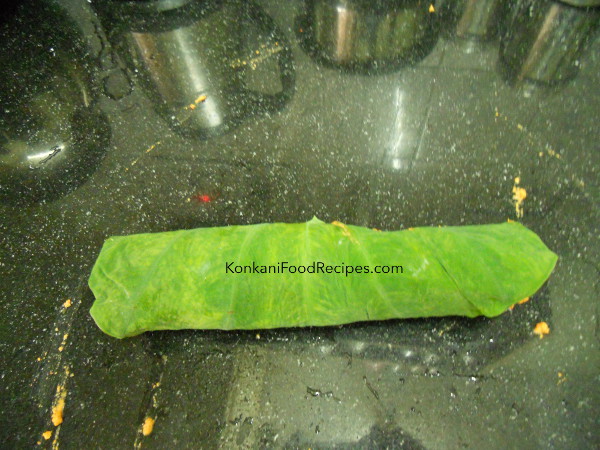


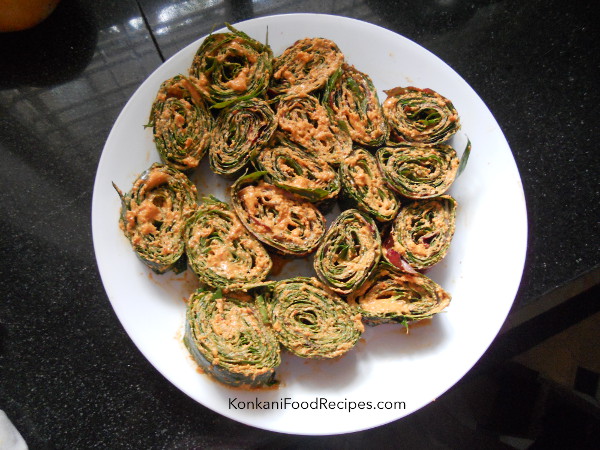

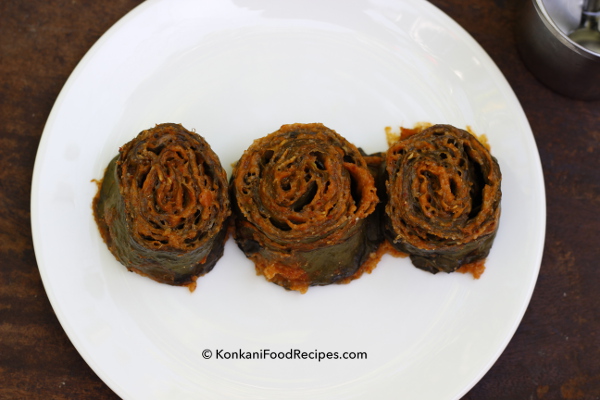
Tweet